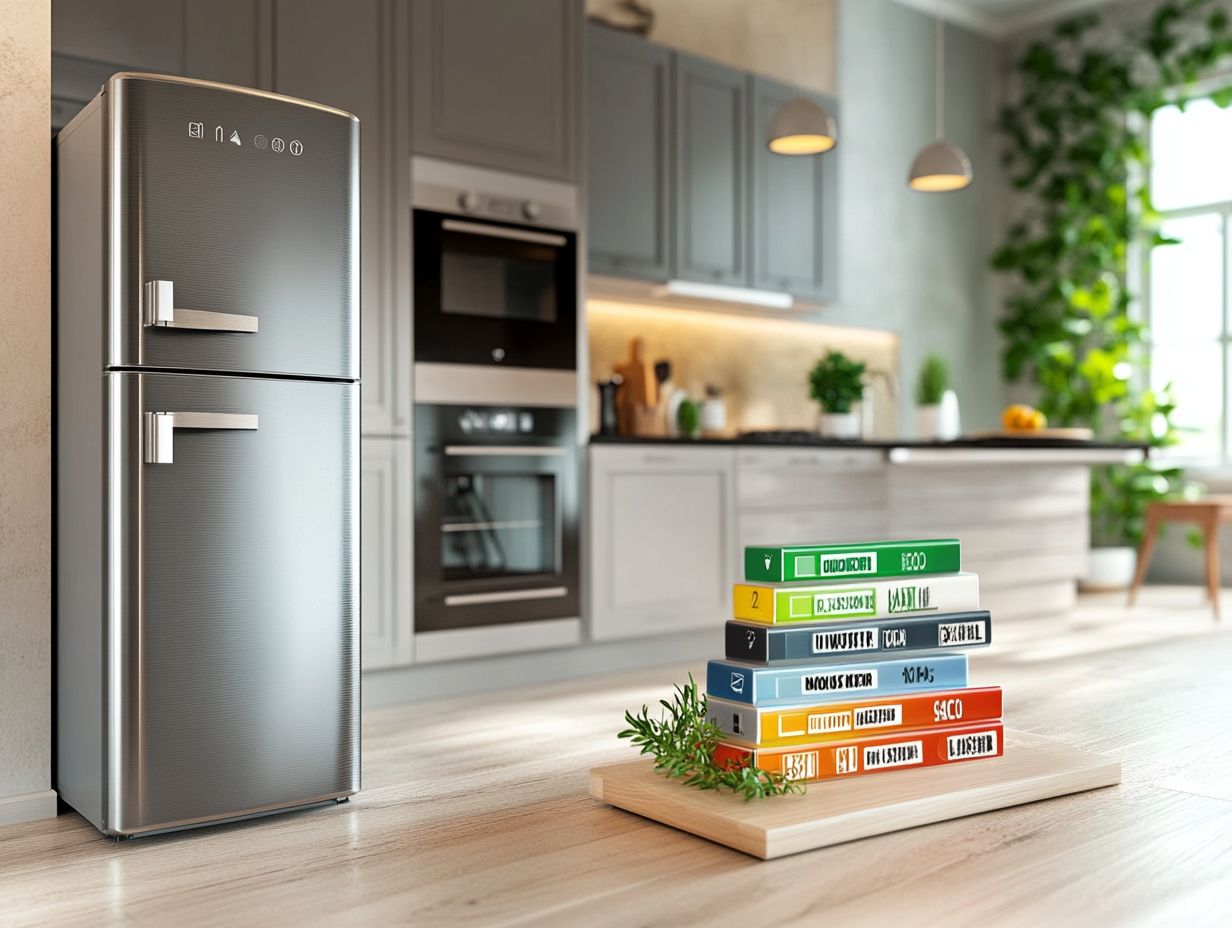Understanding Kitchen Appliance Energy Ratings
In today’s eco-conscious world, understanding energy ratings for kitchen appliances is crucial. This knowledge helps you make informed choices that lead to substantial cost savings and a reduced environmental footprint.
This article explores the benefits of energy-efficient appliances, guiding you on how to read energy labels and highlighting key factors to consider during your selection process.
You’ll find practical strategies for maximizing efficiency in your kitchen while dispelling common myths about energy ratings.
Get ready to turn your kitchen into an eco-friendly paradise!
Contents
- Key Takeaways:
- Benefits of Energy Efficient Kitchen Appliances
- Understanding Energy Labels
- Factors to Consider When Choosing Energy Efficient Appliances
- Tips for Maximizing Energy Efficiency in the Kitchen
- Common Misconceptions about Energy Ratings
- Frequently Asked Questions
- What are energy ratings for kitchen appliances?
- How are energy ratings determined?
- What do the different energy ratings mean?
- Why is it important to understand kitchen appliance energy ratings?
- Do all kitchen appliances have energy ratings?
- What other factors should I consider when buying a kitchen appliance?
Key Takeaways:

Energy ratings help you choose kitchen appliances that save money and are good for the environment.
Understanding energy labels is crucial for picking the most efficient appliances based on size, features, and how you use them.
You can maximize kitchen energy efficiency by unplugging unused appliances and using energy-saving settings.
What are Energy Ratings?
Energy ratings help you evaluate how efficiently your appliances use energy. This knowledge can save you money on your energy bills.
These ratings are displayed on a scale from A to G, with A+++ showcasing the best energy efficiency and the lowest energy consumption per unit. Programs like ENERGY STAR and the EnergyGuide label show you how much energy appliances use, allowing you to compare options like washing machines, refrigerators, and dishwashers.
These organizations play a vital role in promoting energy efficiency by setting the standards that appliances must meet to earn the energy saver designation.
For instance, a washing machine with the ENERGY STAR label uses about 25% less energy and 33% less water than comparable models without this certification. This results in lower utility bills for you and supports environmental sustainability by reducing greenhouse gas emissions.
By opting for energy-efficient models, you can significantly shrink your carbon footprint while enjoying advanced technology and reliable performance.
Benefits of Energy Efficient Kitchen Appliances
Buying energy-efficient appliances is a smart choice. They lower carbon emissions and save you money over time.
These appliances are essential for anyone who cares about the environment. Look for devices with energy-saving settings; they dramatically reduce running costs and energy consumption compared to older models.
This not only extends their lifespan but also contributes to lower energy bills, making your kitchen both eco-friendly and economical.
Cost Savings and Environmental Impact
Energy-efficient appliances save you money. They cut down your household’s energy usage, which lowers your monthly bills.
Using an appliance energy calculator helps you estimate how many hours your devices are running and what they cost you, enabling you to budget and manage resources more effectively.
For example, switching to an Energy Star-rated refrigerator could save you about $200 each year compared to older models, which leads to a notable decrease in your overall utility expenses.
Beyond personal savings, these energy-efficient options benefit the environment by collectively reducing carbon emissions by millions of tons every year. The positive impact on your finances contributes to a cleaner planet, as reduced energy consumption means less reliance on fossil fuels.
As more households adopt these practices, the benefits for individual budgets and the environment become increasingly significant.
Start planning your switch to energy-efficient appliances today and enjoy both savings and a healthier planet!
Understanding Energy Labels

Understanding energy labels is crucial for consumers striving to make informed choices about appliance purchases. These labels provide a clear overview of energy efficiency and consumption metrics of various devices.
You’ll notice a grading system that ranges from A (most efficient) to G (least efficient), often accompanied by certifications like the ENERGY STAR program. This certification means that the appliance meets strict energy efficiency guidelines established by the EPA, helping you choose wisely for both your wallet and the environment.
Interpreting the Information
To interpret the information on energy labels, you need to understand various metrics, including energy consumption comparisons and performance evaluations from energy rating tests for appliances like refrigerators and washing machines. Pay attention to key features such as energy-efficient options, eco programs, and advanced technologies designed to optimize energy usage while minimizing environmental impact.
Check the annual energy consumption figure, typically measured in units of electricity used in a year (kWh), as this gives insight into your long-term costs.
An energy-efficient washing machine, for example, might highlight a consumption of just 200 kWh per year, significantly less than older models. Look for appliances with Energy Star labels; these have undergone rigorous testing to meet strict efficiency guidelines.
Consider extra features like adjustable temperature settings or load-sensing technology, which can enhance energy savings and contribute to a more sustainable home environment.
Factors to Consider When Choosing Energy Efficient Appliances
When choosing energy-efficient appliances, consider these key factors to get the best performance and cost-effectiveness.
Pay close attention to size, features, and overall energy costs. Understanding how dimensions, functionalities, and the use of energy-efficient light bulbs impact energy consumption and utility bills over time is vital for making informed decisions.
Size, Features, and Usage
The size, features, and usage patterns of your appliances significantly impact their energy efficiency and operational costs. Larger appliances can consume more energy if not used correctly, so keep this in mind.
Energy-efficient devices often come with innovative features that optimize performance while minimizing energy consumption, especially during extended use. For instance, a compact washing machine may use less energy than a larger model, particularly if it has advanced settings that adjust water usage based on the load size.
Refrigerators equipped with smart cooling technology maintain optimal temperatures without excessive energy use—ideal for households that store various food items.
To maximize energy efficiency, use timers for devices like water heaters and HVAC systems, ensuring they run mainly during off-peak hours. Regular maintenance of your appliances, such as cleaning filters or checking that refrigerator seals are intact, can further enhance performance.
This not only conserves energy but also meets the unique needs of your household.
Tips for Maximizing Energy Efficiency in the Kitchen

To maximize energy efficiency in your kitchen, implement a range of effective techniques that will dramatically reduce energy consumption and costs.
Embrace energy-efficient products and take advantage of eco mode options in your appliances. This will enhance your energy savings and contribute to a more sustainable household.
Start today and transform your kitchen into an energy-saving powerhouse!
Practical Strategies for Reducing Energy Consumption
Implementing practical strategies to reduce energy consumption can lead to substantial decreases in energy use and lower running costs. Transforming your kitchen into a more eco-friendly space is easier than you might think. Simple changes, like swapping out traditional light bulbs for energy-efficient ones and fine-tuning your appliance settings, can produce impressive improvements in energy efficiency.
Incorporating habits such as meal prepping can also minimize the frequency of cooking. This saves you time and reduces energy usage throughout the week. Research indicates that a well-planned weekly meal can slash energy consumption by up to 25%.
Ensuring your refrigerator is set to the ideal temperature range of 35°F to 38°F can enhance its efficiency. This adjustment can potentially save you an average of $100 annually. By embracing these straightforward yet effective strategies, you can significantly reduce your energy footprint while enjoying a more sustainable kitchen environment.
Common Misconceptions about Energy Ratings
Despite the undeniable advantages of energy efficiency, several prevalent misconceptions linger about energy ratings and their true effect on household energy bills.
Many consumers mistakenly assume that appliances bearing a G rating are suitable for economical energy consumption. However, they are unaware that these choices could lead to considerably higher running costs compared to their energy-efficient counterparts.
Debunking Myths and Clarifying Facts
Debunking the myths surrounding energy-efficient appliances is crucial for understanding their genuine impact on energy efficiency and carbon emissions. You might have heard that buying older models is a more economical choice. However, recent energy rating calculations reveal that modern energy-efficient appliances can drastically cut both energy consumption and harmful emissions.
Studies show that switching to appliances with higher energy ratings can lead to significant reductions in your annual energy bills—sometimes saving you hundreds of dollars each year. There’s a prevalent myth that energy-efficient appliances don’t perform as well as their traditional counterparts. However, extensive research indicates that these modern devices often outshine older options while consuming far less energy.
For instance, the U.S. Department of Energy states that Energy Star-rated products can help households use up to 50% less energy. This exciting data shows how much you can save while significantly lowering greenhouse gas emissions. Embracing energy-efficient technology benefits both your wallet and the environment.
Frequently Asked Questions

What are energy ratings for kitchen appliances?
Energy ratings for kitchen appliances measure the energy efficiency of a particular appliance. They help consumers make informed decisions about which appliances are the most energy-efficient and cost-effective.
How are energy ratings determined?
Energy ratings for kitchen appliances are determined by testing the energy usage of the appliance under standardized conditions. The results are then compared to the average energy usage of similar appliances to determine a rating on a scale from A+++ (most efficient) to D (least efficient).
What do the different energy ratings mean?
The energy ratings for kitchen appliances are based on a scale from A+++ (most efficient) to D (least efficient). An A+++ rating indicates that the appliance is highly energy-efficient, while a D rating means it is not very efficient and will consume more energy.
Why is it important to understand kitchen appliance energy ratings?
Understanding kitchen appliance energy ratings is important because it can help you save money on your energy bills and reduce your environmental impact. Energy-efficient appliances use less energy, which means you will save money on your utility bills and help reduce greenhouse gas emissions.
Do all kitchen appliances have energy ratings?
No, not all kitchen appliances have energy ratings. Generally, larger and more complex appliances, such as refrigerators, dishwashers, and ovens, will have energy ratings. Smaller appliances, like blenders and toasters, typically do not have energy ratings.
What other factors should I consider when buying a kitchen appliance?
When buying a kitchen appliance, energy efficiency ratings matter. But don’t forget to think about size, features, and the brand’s reputation.
Also, consider the overall cost, including maintenance and repair expenses.





